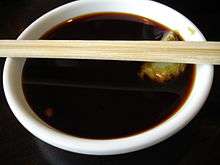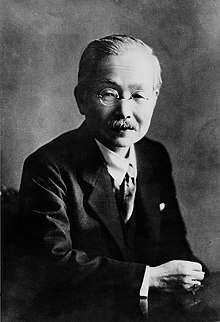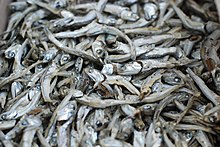Umami
Umami (/uːˈmɑːmi/, from Japanese: 旨味 [ɯmami]) or savoriness is one of the five basic tastes (together with sweetness, sourness, bitterness, and saltiness).[1][2] It has been described as savory and is characteristic of broths and cooked meats.[3][4]

People taste umami through taste receptors that typically respond to glutamates, which are widely present in meat broths and fermented products and commonly added to some foods in the form of monosodium glutamate (MSG) or related substances.[5] Since umami has its own receptors rather than arising out of a combination of the traditionally recognized taste receptors, scientists now consider umami to be a distinct taste.[2][6]
Foods that have a strong umami flavor include broths, gravies, soups, shellfish, fish (including fish sauce and preserved fish such as maldive fish), tomatoes, mushrooms, hydrolysed vegetable protein, meat extract, yeast extract, cheeses, and soy sauce.
Etymology
A loanword from the Japanese (うま味), umami can be translated as "pleasant savory taste."[7] This neologism was coined in 1908 by Japanese chemist Kikunae Ikeda from a nominalization of umai (うまい) "delicious." The compound 旨味 (with mi (味) "taste") is used for a more general sense of a food as delicious.[8][9][10]
Background
Scientists have debated whether umami was a basic taste since Kikunae Ikeda first proposed its existence in 1908.[11][12] In 1985, the term umami was recognized as the scientific term to describe the taste of glutamates and nucleotides at the first Umami International Symposium in Hawaii.[13] Umami represents the taste of the amino acid L-glutamate and 5’-ribonucleotides such as guanosine monophosphate (GMP) and inosine monophosphate (IMP).[14] It can be described as a pleasant "brothy" or "meaty" taste with a long-lasting, mouthwatering and coating sensation over the tongue.
The sensation of umami is due to the detection of the carboxylate anion of glutamate in specialized receptor cells present on the human and other animal tongues.[15] Some 52 peptides may be responsible for detecting umami taste.[16] Its effect is to balance taste and round out the overall flavor of a dish. Umami enhances the palatability of a wide variety of foods.[17] Glutamate in acid form (glutamic acid) imparts little umami taste, whereas the salts of glutamic acid, known as glutamates, give the characteristic umami taste due to their ionized state. GMP and IMP amplify the taste intensity of glutamate.[18] Adding salt to the free acids also enhances the umami taste.[19]
Monosodium L-aspartate has an umami taste about four times less intense than MSG whereas ibotenic acid and tricholomic acid (likely as their salts or with salt) are claimed to be many times more intense.[19]
Discovery

Glutamate has a long history in cooking.[20] Fermented fish sauces (garum), which are rich in glutamate, were used widely in ancient Rome,[21] fermented barley sauces (murri) rich in glutamate were used in medieval Byzantine and Arab cuisine,[22] and fermented fish sauces and soy sauces have histories going back to the 3rd century in China. In the late-1800s, chef Auguste Escoffier, who opened restaurants in Paris and London, created meals that combined umami with salty, sour, sweet, and bitter tastes.[6] He did not know the chemical source of this unique quality, however.
Umami was first scientifically identified in 1908 by Kikunae Ikeda,[23][24] a professor of the Tokyo Imperial University. He found that glutamate was responsible for the palatability of the broth from kombu seaweed. He noticed that the taste of kombu dashi was distinct from sweet, sour, bitter, and salty and named it umami.[12]
Professor Shintaro Kodama, a disciple of Ikeda, discovered in 1913 that dried bonito flakes (a type of tuna) contained another umami substance.[25] This was the ribonucleotide IMP. In 1957, Akira Kuninaka realized that the ribonucleotide GMP present in shiitake mushrooms also conferred the umami taste.[26] One of Kuninaka's most important discoveries was the synergistic effect between ribonucleotides and glutamate. When foods rich in glutamate are combined with ingredients that have ribonucleotides, the resulting taste intensity is higher than would be expected from merely adding the intensity of the individual ingredients.
This synergy of umami may help explain various classical foodpairings: the Japanese make dashi with kombu seaweed and dried bonito flakes; the Chinese add Chinese leek and Chinese cabbage to chicken soup, as do Scots in the similar Scottish dish of cock-a-leekie soup; and Italians combine Parmesan cheese on tomato sauce with mushrooms.
Properties
Umami has a mild but lasting aftertaste associated with salivation and a sensation of furriness on the tongue, stimulating the throat, the roof and the back of the mouth.[27][28] By itself, umami is not palatable, but it makes a great variety of foods pleasant, especially in the presence of a matching aroma.[29] Like other basic tastes, umami is pleasant only within a relatively narrow concentration range.[27]
The optimum umami taste depends also on the amount of salt, and at the same time, low-salt foods can maintain a satisfactory taste with the appropriate amount of umami.[30] One study showed that ratings of pleasantness, taste intensity, and ideal saltiness of low-salt soups were greater when the soup contained umami, whereas low-salt soups without umami were less pleasant.[31] Another study demonstrated that using fish sauce as a source of umami could reduce the need for salt by 10–25% to flavor such foods as chicken broth, tomato sauce, or coconut curry while maintaining overall taste intensity.[32][33]
Some population groups, such as the elderly, may benefit from umami taste because their taste and smell sensitivity is impaired by age and medication. The loss of taste and smell can contribute to poor nutrition, increasing their risk of disease.[34] Some evidence exists to show umami not only stimulates appetite, but also may contribute to satiety.[35]
Foods rich in umami components

Many foods are rich in the amino acids imparting umami, including mother's milk.[36][3] Naturally occurring glutamate can be found in meats and vegetables. Inosinate (another name for IMP) comes primarily from meats and guanylate from vegetables. Mushrooms, especially dried shiitake, are rich sources of umami flavor from guanylate. Smoked or fermented fish are high in inosinate, and shellfish in adenylate.[37]:11, 52, 110[38]
Generally, umami taste is common to foods that contain high levels of L-glutamate, IMP and GMP, most notably in fish, shellfish, cured meats, meat extracts, mushrooms, vegetables (e.g., ripe tomatoes, Chinese cabbage, spinach, celery, etc.), green tea, hydrolysed vegetable protein, and fermented and aged products involving bacterial or yeast cultures, such as cheeses, shrimp pastes, fish sauce, soy sauce, nutritional yeast, and yeast extracts such as Vegemite and Marmite.[3][39]
Taste receptors
Most taste buds on the tongue and other regions of the mouth can detect umami taste, irrespective of their location. The tongue map in which different tastes are distributed in different regions of the tongue is a common misconception. Biochemical studies have identified the taste receptors responsible for the sense of umami as modified forms of mGluR4, mGluR1, and taste receptor type 1 (T1R1 + T1R3), all of which have been found in all regions of the tongue bearing taste buds.[40][41][42] A 2009 review corroborated the acceptance of these receptors, stating, "Recent molecular biological studies have now identified strong candidates for umami receptors, including the heterodimer T1R1/T1R3, and truncated type 1 and 4 metabotropic glutamate receptors missing most of the N-terminal extracellular domain (taste-mGluR4 and truncated-mGluR1) and brain-mGluR4."[15]
Receptors mGluR1 and mGluR4 are specific to glutamate whereas T1R1 + T1R3 are responsible for the synergism already described by Akira Kuninaka in 1957. However, the specific role of each type of receptor in taste bud cells remains unclear. They are G protein-coupled receptors (GPCRs) with similar signaling molecules that include G proteins beta-gamma, PLCB2 and PI3-mediated release of calcium (Ca2+) from intracellular stores.[43] Calcium activates a so-called transient-receptor-potential cation channel TRPM5 that leads to membrane depolarization and the consequent release of ATP and secretion of neurotransmitters including serotonin.[44][45][46][47]
Cells responding to umami taste stimuli do not possess typical synapses, but ATP conveys taste signals to gustatory nerves and in turn to the brain that interprets and identifies the taste quality via the gut-brain axis.[2][48][49]
Consumers and safety
Umami has become popular as a flavor with food manufacturers trying to improve the taste of low sodium offerings.[50] Chefs create "umami bombs," which are dishes made of several umami ingredients like fish sauce.[3][6] Umami may account for the long-term formulation and popularity of ketchup.[51] The United States Food and Drug Administration has designated the umami enhancer monosodium glutamate (MSG) as a safe ingredient. While some people identify themselves as sensitive to MSG, a study commissioned by the FDA was only able to identify transient, mild symptoms in a few of the subjects, and only when the MSG was consumed in unrealistically large quantities.[52]
See also
References
- "Umami – The Delicious 5th Taste You Need to Master!". Molecular Recipes. 24 March 2013.
- Torii K, Uneyama H, Nakamura E (April 2013). "Physiological roles of dietary glutamate signaling via gut-brain axis due to efficient digestion and absorption". Journal of Gastroenterology. 48 (4): 442–51. doi:10.1007/s00535-013-0778-1. PMC 3698427. PMID 23463402.
- Fleming, Amy (9 April 2013). "Umami: why the fifth taste is so important". The Guardian, London, UK. Retrieved 18 February 2017.
- Blake, Heidi (9 February 2010). "Umami in a tube: 'fifth taste' goes on sale in supermarkets". The Daily Telegraph. The Daily Telegraph. Retrieved 10 February 2011.
- "Umami taste receptor identified". Nature. February 2007. Archived from the original on 5 March 2013. Retrieved 26 June 2013.
- Krulwich, Robert (5 November 2007). "Sweet, Sour, Salty, Bitter ... and Umami". National Public Radio (NPR), USA.
- Jim Breen. "EDICT's entry for umami". Retrieved 5 December 2017.
- "うま味 (umami)". Japan Society of Refrigerating and Air Conditioning Engineers. Retrieved 5 June 2017.
- "What is umami?". Columbia University Press. Retrieved 5 June 2017.
- "Umami entry in Cambridge Dictionary". Cambridge University Press. Retrieved 1 January 2011.
- Lindemann B, Ogiwara Y, Ninomiya Y (November 2002). "The discovery of umami". Chemical Senses. 27 (9): 843–44. doi:10.1093/chemse/27.9.843. PMID 12438211.
- Kean S (Fall 2015). "The science of satisfaction". Distillations Magazine. 1 (3): 5. Retrieved 22 March 2018.
- Y. Kawamura; M.R. Kare, eds. (1987). Umami: A basic taste. New York: Marcel Dekker.
- Yamaguchi S, Ninomiya K (April 2000). "Umami and food palatability". The Journal of Nutrition. 130 (4S Suppl): 921S–26S. doi:10.1093/jn/130.4.921S. PMID 10736353.
- Thomas E. Finger, ed. (2009). International Symposium on Olfaction and Taste, Volume 1170. Hoboken, NJ: The Annals of the New York Academy of Sciences.
- Zhang Y, Venkitasamy C, Pan Z, Liu W, Zhao L (January 2017). "Novel Umami Ingredients: Umami Peptides and Their Taste". Journal of Food Science. 82 (1): 16–23. doi:10.1111/1750-3841.13576. PMID 27926796.
- Beauchamp GK (September 2009). "Sensory and receptor responses to umami: an overview of pioneering work". The American Journal of Clinical Nutrition. 90 (3): 723S–27S. doi:10.3945/ajcn.2009.27462E. PMID 19571221.
- Yasuo T, Kusuhara Y, Yasumatsu K, Ninomiya Y (October 2008). "Multiple receptor systems for glutamate detection in the taste organ". Biological & Pharmaceutical Bulletin. 31 (10): 1833–37. doi:10.1248/bpb.31.1833. PMID 18827337.
- Lioe HN, Selamat J, Yasuda M (April 2010). "Soy sauce and its umami taste: a link from the past to current situation" (PDF). Journal of Food Science. 75 (3): R71–76. doi:10.1111/j.1750-3841.2010.01529.x. PMID 20492309.
- Lehrer, Jonah (2007). Proust was a Neuroscientist. Mariner Books. ISBN 978-0-547-08590-6.
- Smriga M, Mizukoshi T, Iwata D, Sachise E, Miyano H, Kimura T, Curtis R (August 2010). "Amino acids and minerals in ancient remnants of fish sauce (garum) sampled in the "Garum Shop" of Pompeii, Italy". Journal of Food Composition and Analysis. 23 (5): 442–46. doi:10.1016/j.jfca.2010.03.005.
- Perry C (1 April 1998), "Rot of Ages", Los Angeles Times, retrieved 29 September 2014
- Ikeda K (November 2002). "New seasonings". Chemical Senses. 27 (9): 847–49. doi:10.1093/chemse/27.9.847. PMID 12438213. (partial translation of Ikeda K (1909). "New Seasonings[japan.]". Journal of the Chemical Society of Tokyo. 30: 820–36.)
- Nakamura E (July 2011). "One hundred years since the discovery of the "umami" taste from seaweed broth by Kikunae Ikeda, who transcended his time". Chemistry: An Asian Journal. 6 (7): 1659–63. doi:10.1002/asia.201000899. PMID 21472994.
- Kodama S (1913). "On a procedure for separating inosinic acid". Journal of the Chemical Society of Japan. 34: 751.
- Kuninaka A (1960). "Studies on taste of ribonucleic acid derivatives". Journal of the Agricultural Chemical Society of Japan. 34 (6): 487–92. doi:10.1271/nogeikagaku1924.34.6_489.
- Yamaguchi S (1998). "Basic properties of umami and its effects on food flavor". Food Reviews International. 14 (2&3): 139–76. doi:10.1080/87559129809541156.
- Uneyama H, Kawai M, Sekine-Hayakawa Y, Torii K (August 2009). "Contribution of umami taste substances in human salivation during meal". The Journal of Medical Investigation. 56 Suppl (supplement): 197–204. doi:10.2152/jmi.56.197. PMID 20224181.
- Rolls ET (September 2009). "Functional neuroimaging of umami taste: what makes umami pleasant?". The American Journal of Clinical Nutrition. 90 (3): 804S–13S. doi:10.3945/ajcn.2009.27462R. PMID 19571217.
- Yamaguchi S, Takahashi; Takahashi, Chikahito (1984). "Interactions of monosodium glutamate and sodium chloride on saltiness and palatability of a clear soup". Journal of Food Science. 49: 82–85. doi:10.1111/j.1365-2621.1984.tb13675.x.
- Roininen K, Lähteenmäki L, Tuorila H (September 1996). "Effect of umami taste on pleasantness of low-salt soups during repeated testing". Physiology & Behavior. 60 (3): 953–58. doi:10.1016/0031-9384(96)00098-4. PMID 8873274.
- Huynh HL, Danhi R, Yan SW (January 2016). "Using Fish Sauce as a Substitute for Sodium Chloride in Culinary Sauces and Effects on Sensory Properties". Journal of Food Science. 81 (1): S150–55. doi:10.1111/1750-3841.13171. PMID 26613570.
- "A new alternative to sodium: Fish sauce". ScienceDaily. 2 February 2016. Retrieved 20 February 2017.
- Yamamoto S, Tomoe M, Toyama K, Kawai M, Uneyama H (September 2009). "Can dietary supplementation of monosodium glutamate improve the health of the elderly?". The American Journal of Clinical Nutrition. 90 (3): 844S–49S. doi:10.3945/ajcn.2009.27462X. PMID 19571225.
- Masic U, Yeomans MR (August 2014). "Umami flavor enhances appetite but also increases satiety". The American Journal of Clinical Nutrition. 100 (2): 532–38. doi:10.3945/ajcn.113.080929. PMID 24944058.
- Agostini C, Carratu B, Riva E, Sanzini E (August 2000). "Free amino acid content in standard infant formulas: comparison with human milk". Journal of the American College of Nutrition. 19 (4): 434–438. doi:10.1080/07315724.2000.10718943. PMID 10963461.CS1 maint: multiple names: authors list (link)
- Ole G. Mouritsen, Klavs Styrbaek (2014). Umami: Unlocking the Secrets of the Fifth Taste. Columbia University Press. ISBN 978-0231168908.CS1 maint: uses authors parameter (link)
- Paul Adams (24 November 2015). "Put the science of umami to work for you". Popular Science, Bonnier Corporation. Retrieved 11 December 2015.
- Hajeb P, Jinap S (2015). "Umami taste components and their sources in Asian foods" (PDF). Critical Reviews in Food Science and Nutrition. 55 (6): 778–91. doi:10.1080/10408398.2012.678422. PMID 24915349.
- Chaudhari N, Landin AM, Roper SD (February 2000). "A metabotropic glutamate receptor variant functions as a taste receptor". Nature Neuroscience. 3 (2): 113–19. doi:10.1038/72053. PMID 10649565.
- Nelson G, Chandrashekar J, Hoon MA, Feng L, Zhao G, Ryba NJ, Zuker CS (March 2002). "An amino-acid taste receptor". Nature. 416 (6877): 199–202. Bibcode:2002Natur.416..199N. doi:10.1038/nature726. PMID 11894099.
- San Gabriel A, Uneyama H, Yoshie S, Torii K (January 2005). "Cloning and characterization of a novel mGluR1 variant from vallate papillae that functions as a receptor for L-glutamate stimuli". Chemical Senses. 30 Suppl 1 (Suppl): i25–26. doi:10.1093/chemse/bjh095. PMID 15738140.
- Kinnamon SC (February 2012). "Taste receptor signalling – from tongues to lungs". Acta Physiologica. 204 (2): 158–68. doi:10.1111/j.1748-1716.2011.02308.x. PMC 3704337. PMID 21481196.
- Pérez CA, Huang L, Rong M, Kozak JA, Preuss AK, Zhang H, Max M, Margolskee RF (November 2002). "A transient receptor potential channel expressed in taste receptor cells". Nature Neuroscience. 5 (11): 1169–76. doi:10.1038/nn952. PMID 12368808.
- Zhang Y, Hoon MA, Chandrashekar J, Mueller KL, Cook B, Wu D, Zuker CS, Ryba NJ (February 2003). "Coding of sweet, bitter, and umami tastes: different receptor cells sharing similar signaling pathways". Cell. 112 (3): 293–301. doi:10.1016/S0092-8674(03)00071-0. PMID 12581520.
- Dando R, Roper SD (December 2009). "Cell-to-cell communication in intact taste buds through ATP signalling from pannexin 1 gap junction hemichannels". The Journal of Physiology. 587 (Pt 24): 5899–906. doi:10.1113/jphysiol.2009.180083. PMC 2808547. PMID 19884319.
- Roper SD (August 2007). "Signal transduction and information processing in mammalian taste buds". Pflügers Archiv. 454 (5): 759–76. doi:10.1007/s00424-007-0247-x. PMC 3723147. PMID 17468883.
- Clapp TR, Yang R, Stoick CL, Kinnamon SC, Kinnamon JC (January 2004). "Morphologic characterization of rat taste receptor cells that express components of the phospholipase C signaling pathway". The Journal of Comparative Neurology. 468 (3): 311–21. doi:10.1002/cne.10963. PMID 14681927.
- Iwatsuki K, Ichikawa R, Hiasa M, Moriyama Y, Torii K, Uneyama H (October 2009). "Identification of the vesicular nucleotide transporter (VNUT) in taste cells". Biochemical and Biophysical Research Communications. 388 (1): 1–5. doi:10.1016/j.bbrc.2009.07.069. PMID 19619506.
- Michail, Niamh (7 October 2015). "Does MSG have a future in Europe as umami gains flavour favour?". FoodNavigator.com, William Reed Business Media Ltd., Crawley, England. Retrieved 19 February 2017.
- Gladwell M (6 September 2004). "Taste technologies: The Ketchup Conundrum". The New Yorker. Retrieved 8 March 2014.
- "Questions and Answers on Monosodium glutamate (MSG)". Silver Spring, MD: US Food and Drug Administration. 19 November 2012. Retrieved 19 February 2017.
Further reading
- Yamaguchi S, Ninomiya K (1999). "Umami and Food Palatability". In Teranishi R, Wick EL, Hornstein I (eds.). Flavor Chemistry: Thirty Years of Progress. ISBN 978-0-306-46199-6.
- Barbot, Pascal; Matsuhisa, Nobu; Mikuni, Kiyomi; Blumenthal, Heston (2009). Dashi and Umami: The Heart of Japanese Cuisine. London: Eat-Japan / Cross Media. ISBN 978-1-897-70193-5.